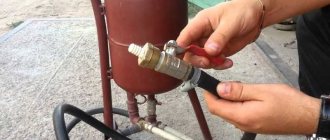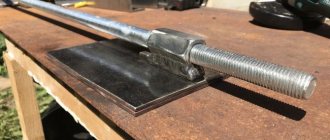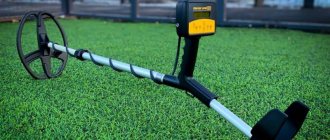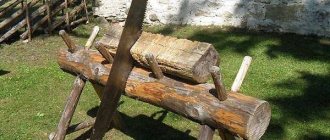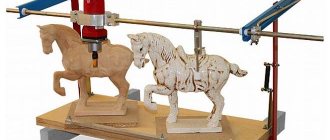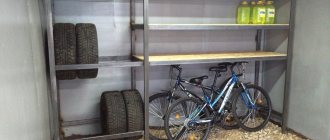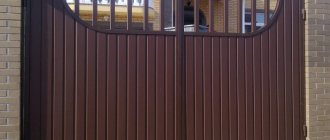Changed and forgot | 04/04/2017
Conventional, non-mechanized cutting of grooves in walls, partitions and floors of buildings is unproductive and dusty work. There are universal wall chasers on sale, but such tools are very specialized and therefore expensive. The price of the most advanced models reaches 20,000 rubles. Today, we will try to find the optimal solution using a wall chaser attachment on an angle grinder. And at the end of the article we will look at homemade versions of this device.
What is a wall chaser
When renovating apartments, homeowners take a new approach to the placement of utility networks and various communications:
- water supply pipes;
- heating lines;
- power cables;
- sewer risers.
It is understandable that apartment owners want to place communications inside the walls and thereby improve the appearance of the premises. The technology for hidden placement of highways involves the creation of special grooves. In the vocabulary of professional builders, such channels are called grooves. For their production, a gas silicate wall chaser is used.
Wall cutter for aerated concrete. The tool began to be used relatively recently. Before its appearance, equipment was used for chiselling grooves that created vibration during operation and negatively affected the strength of building structures:
- a bolt or chisel that was struck with a hammer. The process of creating the grooves was slow and required considerable effort;
- pneumatic hammer. The tool created increased noise and significant vibration. A lot of dust was also present during the formation of the channel;
- industrial hammer drill. During the formation of cavities, vibration negatively affected the strength of concrete and caused the formation of cracks.
The use of these types of equipment required significant physical effort and was characterized by reduced productivity and increased labor intensity. Increased concentration of dust, significant noise and vibration caused a lot of inconvenience. The outdated equipment was replaced by a wall chaser for aerated concrete - a hand-held tool that has many advantages:
- reduces the duration of laying channels in walls;
- reduces the labor intensity of construction operations for gating;
- allows you to provide the necessary channel geometry in various building materials;
- provides the ability to adjust the width and depth of the cavity being formed;
- removes dust from the treated area, reducing dust concentration;
- forms a channel of the correct shape with constant dimensions along the length.
Industrial wall chaser for aerated concrete.
For one-time work, there is no need to purchase an industrial wall cutter for aerated concrete, which is quite expensive. There is a good solution - you can assemble a wall chaser from an angle grinder with your own hands. Drawings are not needed for this modernization, because the design is simple. Using available materials, you can expand the technical capabilities of home tools equipped with an aspiration system. The use of a self-made tool ensures:
- reducing the cost of plastering the groove due to the neat shape of the channel. The resulting groove does not require an increased amount of plaster;
- the ability to cut grooves in building materials with increased hardness. In this case, two cuts are performed at once in one pass.
After processing, all that remains is to remove the cut building material located between the cuts, and you can begin laying communications.
What problems does an electric furrow tool solve?
The best wall chaser for concrete is, of course, electric. Tools of this type are suitable for making grooves not only in brick walls, but also in reinforced concrete and even stone structures. Agree, it would be impossible to handle this manually. The design of this tool resembles an angle grinder. Such a unit is capable of cutting furrows using discs with a diameter of about 150 mm. The discs are attached in the same way as on grinders.
During work, a large amount of dust is generated, and it must be disposed of in a timely manner. Therefore, it is always necessary to work with a vacuum cleaner in parallel with this tool. Basically, all modern tool models are additionally equipped with a special system that connects the vacuum cleaner directly to the furrow machine. It is convenient and a good help for dust removal
It is important to have special clothing when working with this tool: this includes glasses, respirators, and noise protection headphones.
There are power tools specifically designed for concrete. They are distinguished by the presence of rubber rollers, which facilitate the movement of the tool across the working area. The operation of the built-in apparatus begins with the movement of an electric motor by a rotating body with several cutters. For convenience, the instrument has hand holders attached. Often, when working with such a device, additional tools are needed, without which the work cannot be done correctly and efficiently. It is difficult to cope with the work in this case without a level, ruler and pencil for marking.
https://youtube.com/watch?v=YikOFzaEgF0
A little about gating
A groove (the term “furrow” is less commonly mentioned) consists of two parallel grooves, the width and height of the walls of which determine the possibility of installing communications in it. To make grooves, the following groove dimensions are required:
- Width from 3 to 50 mm (the first option provides for laying only power and low-current cables in the groove, the second - for installation of heating system pipes);
- The depth of the groove is no less than its width, but it is better with a small margin of 5...10 mm;
- The bottom of the groove is smooth, without protrusions.
Sometimes you have to cut inclined grooves. For oblique grooves, all specified dimensions are usually increased by 10...12%. The groove should be as even as possible, since any slope of the groove will automatically increase the length of the cable or pipe. The distance from the groove axis to adjacent ceiling structures, openings, etc. must be at least 150 mm, and to the gas pipeline elements - at least 400 mm.
The material of the walls also matters. Since the groove is obtained by removing material from under the tool disk, all dust and stone fragments fall into the worker. Even when performing such work in walls made of foam or aerated concrete, the need for dust collection is very important, since fine dust will remain in the air for a long time.
In a professional wall chaser, all these problems are solved by connecting a vacuum cleaner with a cyclone filter to the tool. Ordinary mesh ones will become clogged with gating products within a few seconds of continuous operation of the wall chaser.
The second significant difference between gating with a specialized tool is the presence of a movable frame with wheels, which, when controlled, can significantly reduce the load on the worker’s hands. A single-disc wall chaser attachment for an angle grinder does not fundamentally solve the problem, since the depth of the groove is not limited in any way, and manual removal of the jumper is very labor-intensive and does not ensure good quality of the bottom of the resulting groove. In addition, during the second pass it will not be easy to achieve parallelism of the walls of the groove.
How to make a groove in a concrete wall
The main document regulating the specifics of making grooves in any tool is SNiP 3.05.06-85. It specifies the rules for creating electrical wiring, all distances and basic safety requirements. By ignoring them, you can not only jeopardize the comfort and safety of people living in the premises, but also be fined.
Before starting work, you need to carefully mark everything, determine the location of the wiring, installation of sockets, switches and other elements. Installation is carried out taking into account the requirements specified below.
SNiP regulatory requirements for gating walls for wiring:
- Load-bearing walls cannot be tapped.
- Channels must be laid parallel to the structures: horizontally or vertically; diagonal grooves cannot be laid.
- The distance between the ceiling and the groove should be at least 15 centimeters.
- There must be a distance of at least 40 centimeters to the gas pipe.
- The depth of the groove is no more than 2.5 centimeters.
- Before laying new wiring, you need to check the walls for the presence of old ones (if it is not a new building).
- The grooves are laid exclusively vertically/horizontally; no oblique lines are allowed. An exception may be the need to lay wiring on walls with a slope (attic, for example), when the line can be run parallel to the slope of the wall.
- You can turn the groove between two points only once: each turn represents a bend in the cable, which heats up more in such places. And if there are a lot of turns, the danger of operation increases.
- The size of the grooves should be as follows: maximum width 3 centimeters, depth no more than 2.6 centimeters. The total length of the line from the junction box to the point should not be more than 3 meters.
- Optimal distances: from batteries and gas pipes 40 centimeters, to the door 10 centimeters, from the floor - at least 5 centimeters (but better than 10).
- It is forbidden to touch reinforced concrete structures during the gating process, but if you do this, do it in such a way as not to touch the reinforcement frame and with a minimum groove depth.
- It is prohibited to scratch internal load-bearing walls; on the first floors, work is carried out very carefully, since here the walls support the entire building.
- Grooving in the ceiling is carried out by calculating the shortest path to the lighting point.
- Cutting grooves in floor slabs is prohibited. When a line is laid across the floor, it is embedded in a concrete screed, which is poured taking into account the need to lay furrows.
- During the work process, be sure to take care of personal protective equipment - a respirator or mask is suitable for these purposes.
Wall chaser for foam blocks - design features
Manual tools for grooves can be manufactured in the following design options:
- based on a regular grinder. The design provides for the installation of two concrete cutting discs on the device shaft, between which a sleeve of the required length or the required number of washers can be installed. By changing the length of the spacer element, the interval between the cutting discs is adjusted, corresponding to the width of the channel;
- modernized version. It is an improved version of the grinder, on which, in addition to two circles, a casing made of metal sheet is mounted. Dust generated during the gating process is removed through a pipe attached to the metal casing of the aspiration device;
Wall chaser based on a regular grinder
- based on a hand grinder. An improved version of the tool is similar in design to a grinder with an aspiration casing. A distinctive feature of the design is the presence of a mobile platform with wheels, fixed at the bottom of the dust receptacle. This option allows you to easily move the device along the wall without applying significant effort.
An electric wall chaser for a gas block is more efficient than a manual tool due to the following points:
- increased cutting speed;
- smooth surface of the groove walls;
- clear channel geometry;
- increased security;
- aspiration possibilities.
Modern electric scoring tools include:
- protective casing. It prevents the operator from being injured by fragments when rotating the disks;
- aspiration pipe. Provides dust extraction from the work area when connected to a vacuum cleaner;
- work site. Provides smooth movement of the device along the wall and allows you to adjust the depth of the groove;
- working handle. It can be installed in various places of the casing, providing a convenient location for the device when cutting;
- electric drive. Accelerated slitting is provided with a power of 2 kW and a spindle speed of 5500 rpm.
Design and principle of operation of the furrow maker
Main design elements of the tool:
- The engine is enclosed in a durable plastic housing.
- The gearbox is located in a metal housing.
- Handle for carrying and holding while working.
- Main operating handle with start button.
- Protective metal casing.
- Connection for connecting the vacuum cleaner hose.
- Non-slip rollers allow you to move the tool without much effort.
How does a wall chaser work:
- First, connect the vacuum cleaner hose to the fitting.
- A diamond disc is placed on the spindle.
The first disk is put on the spindle
Several washers to adjust the groove width
The discs are installed and secured with a pressure washer
When you turn on the tool, the engine starts running. Its rotation is transmitted to the gearbox and then to the spindle with disks. The wall chaser is immersed into the surface of the material being processed to a set depth. The master holds the tool with both hands and moves it in the desired direction. The discs cut furrows as they move. Dust is sucked into the hose through a pipe in the casing.
Application benefits
Wall chipping is a difficult, troublesome task that takes a lot of time and effort. Previously, a variety of devices were used for such work: a chisel and chisel, a hammer drill, an angle grinder. But it is much more convenient and efficient to use a wall chaser or an attachment on an angle grinder for chasing.
So, using a specialized tool has the following advantages:
- The speed of work completion increases significantly, and labor costs are reduced.
- Can be used in conjunction with a construction vacuum cleaner.
- Work safety increases.
- It is easy to adjust the width and depth of the groove.
- The grooves are smooth, without chips or drops.
Wall chaser design and functions
Structurally, this universal tool is most similar to an angle grinder (angle grinder), which in everyday life is called an angle grinder. It is widely believed that this is an angle grinder with two discs. Frankly speaking, it is almost correct. The main difference is that the wall chaser is equipped with a powerful electric motor, usually with the ability to control speed and smooth start. Good models have overheating and overload protection functions. In case of significant loads, they will allow you to save the tool.
The wall chaser uses diamond discs, the distance between them is adjusted to obtain a groove of the required width (usually up to 60 mm). For safety reasons, they are covered with a special casing. In addition, the casing has an outlet for connecting a vacuum cleaner, this allows minimizing the emission of dust during gating. To obtain the required depth, it is equipped with a special adjustable stop (usually up to 80 mm).
With the help of an attachment for an angle grinder, you can completely replace the wall chaser.
Rating of the TOP 7 best dust extractors for an angle grinder
| Place | Model | Price |
| #1 | DIOLD KZV-125 | |
| #2 | DIOLD KZV-125 U | |
| #3 | Mechanic Air Duster 125 (19568442013) | |
| #4 | DIOLD KZV-125 R | |
| #5 | DIOLD KZV-180 | |
| #6 | Grilling housing for angle grinders, 125 mm, DEWALT DWE46225-XJ | |
| #7 | Mechanic Air Duster 230 (19568442014) |
Page navigation:
Features of choosing a tool
When there is a need to purchase such a tool, it is better to follow simple instructions:
- Select the required power of the tool. Here it is important to be guided by the amount of work ahead. Low-power wall chasers (up to 1.3 kW) are suitable for solving small household problems. Medium-power tools (1.3 kW - 2 kW) can cope with all household tasks, they heat up much less than their low-power counterparts, and their service life is much longer. It makes sense to buy powerful models over 2 kW only for regular and very large, volumetric work. In addition, the more powerful the tool, the heavier it is. This feature should also be taken into account.
- Determine such characteristics as the required maximum depth and width of the groove, the possibility of cutting the groove at an angle, the range of regulation of the electric motor speed.
- Availability of additional options: slip clutch, protection against overheating and overloads, a brush wear control system, the ability to use it in “grinder mode”, the presence of a vibration protection system.
Homemade tool from an angle grinder
Considering the high rotation speeds of the cutting wheel, the best solution would be to purchase a special attachment, which is affordable, and an angle grinder can be found in almost every home. To adapt it for cutting furrows, you need to install:
To install the second cutting wheel, select an additional separating washer. The distance between the disks, as well as the width of the groove, depends on the length of the gearbox spindle . You can set the required distance using several standard nuts.
What kind of lighting do you prefer?
Built-in Chandelier
The first cutting wheel installed on the working shaft is fixed with a standard nut, which will serve as a separating sleeve. The second is fixed with a nut for the grinding disc, which is included in the angle grinder kit, but this nut is screwed up from the bottom. The resulting distance will be enough to cut a groove in the wall for electrical wires.
Special discs are installed for cutting grooves; using others is strictly not recommended!
Since the grinder is not designed to withstand loads twice as high as the standard ones caused by installing an additional cutter, in order to prevent overheating or short circuiting, a break is taken every 15-20 minutes to cool the electric motor, gearbox, and commutator.
Electric
This is a powerful tool that has two rubber rollers that help the wall chaser move easily along the wall surface being processed. This furrower is equipped with comfortable handles and several cutters that move thanks to a built-in electric motor. Designed for cutting grooves in various hard building materials.
This is a fairly simple construction tool, but its use requires certain skills and experience from the master. Also, when working with power tools, you should remember to wear personal protective equipment, as they create a lot of construction dust and noise.
What features of dust extractors for grinders should you pay attention to when choosing?
When planning to purchase a dust extractor for a sander, pay attention to the following points:
- Well-known, well-established manufacturers rarely fail. Therefore, if you have the financial opportunity, purchase a device from a well-known company.
- Buy a casing with the highest level of protection for working with brickwork, stone and concrete surfaces.
- Choose a model that is suitable for modifying your existing angle grinder and with the appropriate nozzle size , otherwise the casing will not be able to be correctly aligned and secured properly, and it will allow dust to pass through.
- The casing must be safe for humans , so powder coating on the surface is an ideal choice.
- The kit must contain an instruction manual, technical description and certificate.
Do-it-yourself wall chaser from an angle grinder
A wall chaser is a rather rare tool that not everyone has, but almost every home craftsman has an angle grinder. As already noted, structurally, these tools have a lot in common, so for home use you can easily make a wall chaser from an angle grinder with your own hands.
To begin with, it should be noted that you can use a grinder for slitting without any modifications, but it will be inconvenient, dusty and ineffective. A wall chaser is incomparably more convenient in this regard, but it is expensive. The rework will not require any special material or time costs.
We should start with the main difference - the wall chaser has two discs, and the grinder has one. It is necessary to order or grind yourself a nut with an additional ring to secure the second disk. The first disk will be secured in the usual way, and the second one directly to this nut. It is best to make several nuts of different thicknesses so that you can adjust the width of the groove. It is necessary to pay attention to the length of the shaft; it should be enough to mount two disks. It may be necessary to purchase or manufacture an extended shaft. Read about how to make a casing for connecting a vacuum cleaner here.
The second stage is the manufacture of a groove depth limiter. It is much more convenient and easier to work with him. You should also make a support plane so that the grinder with the attachment can be moved along the groove.
At the last stage, a homemade protective casing is made. By the way, the depth limiter can be combined with a protective casing, which is very convenient and greatly simplifies the entire design. It is necessary to provide an exhaust pipe in the casing for connecting a vacuum cleaner, otherwise it will be almost impossible to work in a closed room due to the high concentration of dust. It is absolutely forbidden to work without a protective casing - the likelihood of injury, even death, is extremely high.
Homemade wall chaser - the simplest option
Without making major changes to the design of the angle grinder, you can quickly and cost-effectively produce a simple device for grooving by fixing one disk on the shaft for working on concrete.
Procedure for working with the tool:
- Attach a disc to the shaft for working on concrete.
- Make markings on the surface to be treated.
- Make two passes and form a groove of the desired size.
This method has disadvantages:
- it is problematic to ensure size stability;
- it is difficult to maintain the depth of the groove.
Homemade wall chaser If you increase the length of the spindle, you can install a pair of concrete disks on it and form a channel in one cycle. This will save time, but will not solve the problem of dust formation.
Do-it-yourself wall chaser from an angle grinder
A wall chaser is a rather rare tool that not everyone has, but almost every home craftsman has an angle grinder. As already noted, structurally, these tools have a lot in common, so for home use you can easily make a wall chaser from an angle grinder with your own hands.
To begin with, it should be noted that you can use a grinder for slitting without any modifications, but it will be inconvenient, dusty and ineffective. A wall chaser is incomparably more convenient in this regard, but it is expensive. The rework will not require any special material or time costs.
We should start with the main difference - the wall chaser has two discs, and the grinder has one. It is necessary to order or grind yourself a nut with an additional ring to secure the second disk. The first disk will be secured in the usual way, and the second one directly to this nut. It is best to make several nuts of different thicknesses so that you can adjust the width of the groove. It is necessary to pay attention to the length of the shaft; it should be enough to mount two disks. It may be necessary to purchase or manufacture an extended shaft. Read about how to make a casing for connecting a vacuum cleaner here.
The second stage is the manufacture of a groove depth limiter. It is much more convenient and easier to work with him. You should also make a support plane so that the grinder with the attachment can be moved along the groove.
At the last stage, a homemade protective casing is made. By the way, the depth limiter can be combined with a protective casing, which is very convenient and greatly simplifies the entire design. It is necessary to provide an exhaust pipe in the casing for connecting a vacuum cleaner, otherwise it will be almost impossible to work in a closed room due to the high concentration of dust. It is absolutely forbidden to work without a protective casing - the likelihood of injury, even death, is extremely high.
An angle grinder with a power of at least 1500 W is suitable for conversion.
What you will need
Of the basic materials for making homemade products, we will need:
- thick steel washers (you can buy or turn them on a lathe with your own hands);
- extended couplings;
- long bolt (it is advisable to choose one with a high strength class);
- housing bearing;
- sheet metal;
- angle grinder discs designed for working with concrete and stone.
Now let's start making an attachment for the grinder for gating.
Drawings and diagrams
The simplest version of a homemade attachment for an angle grinder is shown in the photo and diagram. The design is a detachable metal cover, mounted on an angle grinder instead of the standard steel half casing.
The dimensions of the protective casing of the attachment are selected based on the power and dimensions of the grinder itself, as well as the diameter of the cutting wheels.
The larger the disc, the more expensive it will cost to operate the grinder. For a home, a disc of 125-150 mm is sufficient; circles of 180-190 mm will require use with a 2 kW motor. Moreover, for the body of the grinder attachment you will have to use metal 3-3.5 mm thick, which noticeably makes the tool heavier.
Stages of work
The first step is to make three washers - using a crown, we cut out three blanks from a sheet of metal. Then the author turns them on a lathe.
Next we need two extended couplings. One of them needs to be shortened. Then the master processes the couplings on a lathe - on one side of each coupling it is necessary to machine a seat for the washer.
After this, in two prepared metal washers, using a step drill, we drill out the central hole to the desired diameter. We put washers on the elongated couplings and scald them.
We clean the weld seams with a grinder. We prepare two ordinary washers, a long bolt and a housing bearing.
All prepared parts will need to be assembled in the following order:
- We put a regular metal washer on the long bolt.
- Then install the housing bearing.
- We put on another washer (regular).
- We put a thick washer on the bolt with a groove for the disc (which we made earlier).
- We install the saw blade on concrete.
- We screw a cut-off elongated coupling with a welded washer onto the bolt.
- We screw on the second extended coupling with a washer.
- We install a second concrete saw blade on the grinder.
- After this, we screw the assembled structure onto the gearbox shaft of the angle grinder.
Making a protective casing
We cut out three parts from sheet metal about 3-4 mm thick: the side walls and the upper part of the protective casing.
We make a fastening clamp. Then we weld it to one of the side walls.
We weld the entire protective casing for the wall chaser - there should be enough space inside to install two disks. It will additionally be necessary to weld a mount to it to install the handle.
At the last stage, all that remains is to assemble all the parts together: we attach the protective casing to the grinder, install the first disk, then install the shaft with the housing bearing, couplings and disk. Everything needs to be secured well.
For details on how to make a homemade wall chaser attachment for an angle grinder, you can watch the video below. This idea was shared by YouTube channel creator Sean Beardon.
Recommendations for gating
Before ditching the wall, you will need to make a marking and cut along it - this is much more convenient, and the result will be of better quality.
Please note: it is best to cut a wall groove from top to bottom.
The depth of the groove for one cable is at least 15 mm. If several cables will be laid in one groove, the depth of the groove must be increased. The main condition is that the cables fit freely into the groove and do not stick out of it.
The width of the groove must be such that a hammer blade or chisel can fit into it.
When slitting walls, a lot of dust is generated, so it is advisable to provide for the possibility of removing it. For this, a construction vacuum cleaner is used, the hose of which is connected to a pipe attached to the protective casing.
Assembling the wall chaser
If you have a new nut, all that remains is to assemble a homemade furrow maker as follows:
- mount the first circle on the shaft;
- install the bushing that was made together with the nut;
- place the second cutting disc on top;
- we pass the modernized nut through it and tighten it until it stops; As a result, the fastening element fixes the first disk and prevents the second one from jumping off the shaft.
At the last stage, a protective casing is installed, to the nozzle of which the vacuum cleaner hose is connected.
Features of marking diamond discs
Product labeling is designed to provide the user with maximum necessary information and simplify their identification. It is usually applied to diamond discs using laser engraving. It includes:
- manufacturer's logo;
- name of the model and its article number;
- direction of rotation;
- maximum linear speed or permissible number of revolutions per minute;
- references to the manufacturing standard;
- information about the disc quality class;
- diameter of the disk and its mounting hole.
Often, manufacturers of metal cutting wheels indicate the name of the material for which it is better to use a disc of this brand.
How to properly operate a manual wall chaser on aerated concrete
After assembly, you should check the functionality of the device on a pre-marked cutting area and learn operating skills. Sequencing:
- Assemble the discs with the bushing on the shaft and tighten them with a nut.
- Set the required groove depth and turn on the aspiration unit.
- Press the power button after connecting to the network.
- Touch the marked surface and groove.
The device should be moved after the discs are immersed to the desired level. It is important to monitor engine heating and periodically stop the engine to cool.
Adjusting the cutting depth
Almost all models of wall chaser attachments for industrial angle grinders use roller guides with an oscillating sole. It is easy to make such a system with your own hands.
The cutting depth adjustment system looks like a frame, the front edge of which is fixed to the casing using a hinge, and the opposite side is fixed with a bolt-nut fastening. When the wing or bolt head rotates, the back bar with rollers deflects, which allows you to accurately adjust the depth of the wall chaser nozzle disk.
How it works and how it works
The furrow maker's design is similar to that of an angle grinder. The rotation of the working disks is carried out by a powerful high-speed electric motor of the asynchronous type. Through the gearbox, rotation is transmitted to the spindle, to which diamond discs are attached. This is where the similarity with the grinder ends.
Wall cutter device
A distinctive part of the furrow machine is a voluminous casing designed to capture and remove dust. As a rule, the casing has several seats for additional handles. This allows you to choose the optimal position of the tool during operation. The casing is located on a mobile platform, which is equipped with wheels in the lower part. There can be from 2 to 4. By rolling the platform along the wall, the operator cuts a furrow along a pre-designated line. Thanks to this device, there is no need to adjust the degree of pressure and the wall chaser easily glides along the rough surface of the wall. On one side of the casing there is a pipe for removing dust. The suction tube of the vacuum cleaner is connected to it.
The vacuum cleaner hose is connected to the dust extraction pipe.
There is also a cutting depth adjustment device located on the casing body. In different models you can find different design solutions for this function. But the general principle is that the casing moves relative to the movable platform and is fixed in the desired position. The cutting depth is marked on the outside of the housing.
The ruler on the body shows the depth of the discs into the wall surface
It should be added that many wall chasers are equipped with additional electronic equipment. This increases their cost, but also increases their performance characteristics. Such systems include:
- Adjusting engine speed. Provides the user with the ability to manually adjust the disk rotation speed. This is relevant when gating walls made of various materials (brick, concrete, cinder block, foam concrete, etc.)
- Soft start system. A very useful feature for extending the service life of the tool and ensuring an increased level of safety during operation. As practice has shown, most breakdowns of this type of equipment occur when the engine suddenly starts.
- Automation of disc braking. Reduces the time of complete stop of rotation after turning off the engine, dampens inertia.
- Anti-vibration device. With its help, micro vibrations of the wall chaser are absorbed during operation. When using the tool for a long time, the operator may experience the problem of “tremor” - poor circulation in the hands.
- Motor blocking when overheated. The “weakness” of all asynchronous motors is that at high loads, the armature windings heat up sharply, even to the point of melting. Outwardly (except for an increase in temperature) this is not expressed in anything, and this is a danger - the motor may fail.
It is precisely because of the equipment with these functions that many wall chasers from such reputable companies as Bosch, Makita and others have a high cost.
But you need to understand that without them the tool will last much less time.
Hammer
Another common and fairly simple way to make a wall chaser yourself is to use a hammer drill. But instead of the usual drill, you should insert a cutter of the required size into it.
Such a wall chaser is quite simple and does not require much time and effort to manufacture, but at the same time it produces a very low quality of work. The groove is not only curved in height and length, but also of different depths and widths. As a result, you will have to spend much more time on gating and a much larger amount of finishing materials.
What to make a protective dust cover for an angle grinder from
The manufacture of a protective casing involves the use of such types of materials as a plastic canister, aluminum pans, chipboard, plywood, laminate, board, stainless sheets, etc. You can choose any material that is available on the farm. This eliminates the need to buy an attachment, since making it with your own hands is very easy and simple.
The main condition is to ensure sufficient strength of the finished attachment for the grinder. The casing must withstand the impact of small particles of concrete flying out during work. To make the casing, there is no need to resort to the use of auxiliary tools, such as welding, since a nozzle can be quickly made from a plastic canister. An example of such a nozzle is shown in the photo below.
The manufacture of such a device requires a minimum of time. A homemade wall chaser from an angle grinder can be made quickly and easily, using an arsenal of improvised tools. If you use materials made of aluminum or wood, then when working on the manufacture of nozzles you will need self-tapping screws, and when using steel you cannot do without a welding machine. Let's consider the principle of making a wall chaser attachment for an angle grinder with your own hands:
- For production you will need leftovers from chipboard or fiberboard. In addition, even plywood will do, so we use any sheet material that is available
- Two side bases are cut out of chipboard according to the appropriate shape. The shapes of these bases depend on the size of the available tool
- To avoid having to select a shape, it is recommended to first make a drawing on paper and then transfer it to cardboard. Make a template from cardboard, eliminating all the shortcomings
- Based on the template, make a cover using chipboard
- Drill a hole of the appropriate diameter on one side of the chipboard base. Use this hole to secure the finished attachment to the power tool.
- To connect chipboard when making the nozzle, you can use self-tapping screws or special furniture fasteners of appropriate length
The photo below shows the resulting case for the grinder. Such a cover is easy to make, but its drawback is the absence of a hole for connecting a hose. A sleeve of the appropriate diameter and length, which must be mounted in the upper part of the structure, will help eliminate this drawback. A hose from a vacuum cleaner should be connected to the protrusion of the sleeve.
This is interesting! When using a vacuum cleaner to suck up debris and concrete chips, it is recommended to use industrial or construction vacuum cleaners, but not household ones. They are not designed for such things, so in the end they can quickly fail.
The process of making a nozzle is not difficult, and the quality of the final device depends more on the ingenuity and imagination of the master. You can make not just a simple case for an angle grinder with your own hands, but also an adjustable one. The principle of manufacturing an adjustable protective casing is that you need to make an additional moving part. Due to this moving part, the required size of the protrusion of the cutting discs on the grinder will be selected.
In a similar way, you can make a nozzle with an adjustable part from chipboard and other materials.
Accessories for grinding machine
Considering that the design of a furrower is similar to a grinder, craftsmen have learned to make wall chasers from an angle grinder with their own hands. These mechanisms cut concrete walls without dust; for this they adapt a vacuum cleaner. Installing a groove in a concrete wall is a difficult task. Powerful machines are used for this operation. This is not possible at home, so craftsmen use a grinding machine and a diamond wheel to cut concrete. To reduce dust in the room during operation, install a homemade nozzle connected to a vacuum cleaner.
The design of the nozzle is simple. A section of sewer pipe with a diameter of 60 and a length of 500 millimeters is attached to the lower part of the angle grinder body using construction tape. Make a 20 mm wide cut on the upper wall of the pipe end to allow the cutting tool to enter. During operation, the circle rotates counterclockwise, then all the dust and concrete fragments fall into the pipe, where they are captured by the air stream and fed into the vacuum cleaner’s storage tank.
An angle grinder is designed mainly for grinding the surface of a material and cutting metal, so a cutting tool in the form of a thin disk is used. To chisel walls, you need a grinder with two discs. Installing two drives is not difficult. To do this, you need to buy a clamping nut in the store. Then a diamond disk and a special nut are installed on the seat of the machine, on which the second diamond wheel sits and is secured with the purchased nut. The created mechanism can easily be called a wall chaser.
Homemade protective casing
Safety when working on homemade equipment cannot be neglected. All grinders have high speeds, which can cause the circle to break and injure the worker. Therefore, you need to ensure that the mechanism has a protective casing. The efficiency of work largely depends on the power of the machine and the density of the material being processed. There are many different problems that determine the optimal characteristics of choosing a diamond wheel, especially when it comes to selecting a cutting tool for high-performance cutting.
In order to reliably protect yourself from the effects of dust and damage from rupture of the cutting tool, experienced specialists suggest making a closed casing with a pipe for the angle grinder for wall slitting. The design of the homemade product is simple. The idea was taken from a standard casing, a platform, a side cheek, a pipe and a cutting depth regulator were added. Drawings for the product are made in the form of sketches as work progresses, taking into account the availability of the necessary materials. Manufacturing process:
- The platform is made of sheet steel 2 mm thick. Base size 250x90 mm. A window is cut along the center line for the exit of the cutting wheel.
- A hinge is welded on one edge of the base to adjust the cutting depth, and on the other there is a bracket with a slot for fixing.
- The cheeks are made of steel sheet two millimeters thick. The shape is in the form of a semicircle, covering two thirds of the cutting tool.
- The width of the casing is 40 millimeters. The hinge axis is welded at one end, and at the other there is an M6 pin with a wing for fixation.
- The outer cheek has a connection for the vacuum cleaner hose and a clamp for attaching to the neck of the angle grinder.
Furrow maker for aerated concrete
Aerated concrete, compared to concrete, is easier to cut, so you can use any power tool that you have in your home workshop: a drill, a hammer drill, a hand-held circular saw. The idea goes like this. Buy a key cutter for metal, install it in a hammer drill and mill a groove according to the markings. To make the operation easier, you need to make a simple nozzle from wood. To do this, you will need two slats 300x50x30 millimeters, two pieces of wood measuring 300x150x20 mm.
Technological process for manufacturing the device:
- Make a sled. To do this, attach two prepared slats with screws to the base, in which a hole is cut for the cutter to exit.
- Attach a bracket made of boards perpendicularly to the base to support and secure the power tool.
- Make a plank carriage with a hole for the neck of the hammer drill.
- Before work, set the cutting depth by placing wooden blocks under the carriage and base.
What recommendations and tips to consider when gating
You can begin the procedure for preparing grooves indoors immediately after making your homemade product. When punching a groove, one important nuance must be taken into account - the work should be carried out in a room where the location of the electrical wiring is previously known. If a live wire is encountered along the path of the tool, the result of such an encounter can be fatal for the master.
It is necessary to carry out gating work with both a conventional wall chaser and an angle grinder, taking into account the following tips and recommendations:
- Procedures can be carried out in vertical or horizontal directions
- It is possible to ditch at an angle in extremely rare cases when it is necessary to bypass a decorative element or communications
- Horizontal grooves must be carried out exclusively at a distance of up to 15 cm from the floor slab
- Vertical grooves must be located at a minimum distance from doors and windows of 10 cm
- When carrying out work, it is important to take into account the depth of the groove. It is necessary to select the depth depending on the type of communications that are planned to be laid in the groove, as well as the thickness of the wall itself. If this wall is load-bearing and is external, then the depth of the groove should not be more than 3 cm
- The width of the groove is also selected depending on the technological task, but it is not recommended to exceed the permissible limit of 2.5-3 cm
After laying communications, the groove should be sealed with cement mortar. The location of the groove should be leveled with the plaster of the wall. It is recommended to carry out gating work at the construction and repair stage before plastering the walls.
It is not at all difficult to make a wall chaser for concrete from an angle grinder, and if you set yourself such a goal, then everyone can achieve it. When drawing a conclusion about the work done, it should be noted that when chipping, you need to take breaks to allow the power tool to cool down. If the cover does not have a connector for connecting a vacuum cleaner, then work must be carried out in a respirator. Glasses must be worn in any case, as various small particles can get into the eye.
Depending on the type of material that is being cut, it is necessary to select the appropriate speed of movement of the tool. If you come across reinforcement in a concrete wall on the way, it is recommended to saw it with an abrasive wheel. It is necessary to use a wall chaser on wood with extreme caution, not forgetting about the backlash.
Why do you need to trench a wall?
So, gating is the gouging of grooves in walls and ceilings for laying electrical wiring and piping systems. To lay and hide electrical, antenna or telephone wires and cables, we also use gating. When installing an air conditioner, the wall also needs to be tapped.
If you need to hide existing wiring, we make a channel (groove) in the thickness of the plaster or concrete, lay wires or cables there and putty. We also hammer walls when it is necessary to mount internal models of electrical sockets or switches.
Such models are built into the wall, so you need to make a round hole corresponding to the size of the switch or socket.



